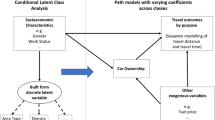Abstract
A major problem with aggregate transport planning models is the accounting of variability in traveller behaviour when the basic unit of analysis is the geographical traffic zone. In an attempt to allow for this variance, recent attention has been given to the role of socio-economic (user and household) characteristics in systematically identifying a homogeneous grouping of travellers with respect to the issue under study rather than restricting the grouping definition according to physical geographical criteria alone. This homogeneous grouping criterion combined eventually with a necessity to represent travel demand in a spatial context, can assist in improving our ability to explain real travel patterns by the development of an improved aggregation condition. The emphasis is on modelling homogeneous groups of travellers separately, and then relating the individual sets of results to each other to obtain an aggregate prediction of behaviour via a knowledge of the representativeness of each group contained in the total sample. This paper presents a technique to identify the relative homogeneity of travellers in accordance with a specified criterion, and illustrates its use with individual household data for the Sydney Metropolitan Area. The paper concludes with a discussion of the advantages of segmentation in operational transport planning, in particular with reference to the “aggregation” of disaggregate behavioural travel choice models, or movement from a micro-model of individual choice behaviour to an aggregate model of travel demanu.
Similar content being viewed by others
References
Brand D. and Manheim, M. C., eds. (1973), Urban Travel Demand Forecasting, Proc. Conf. Urban Travel Demand Forecasting, Williamsburg, Virginia, 1972. Transportation Research Board Special Report No. 143, Washington, D.C.
Constantino, D. P., Dobson, R. and Canty, E. T. (1974). “An Investigation of Modal Choice for Dual Mode Transit, People Mover and Personal Rapid Transit Systems”, Internat. Conf. on Dual Mode Transportation, Washington, D.C.
Dobson R. and Nicolaidis, G. C. (1974). “Preferences for Transit ‘Service’ by Homogeneous Groups of ‘Individuals’”, Proc. American Transportation Research Forum.
Domencich, T. and McFadden, D. (1975). Urban Travel Demand, Rotterdam: North-Holland Press.
Frank, R. E., Massy, W. F. and Wind, Y. (1972). Market Segmentation, Princeton: Prentice-Hall.
Hartgen, D. (1972). “A Note on the Ability of Socio-Economic variables to Explain Attitudinal Bias Toward Alternative Travel Modes,” High Speed Ground Transportation, Vol. 6, No. 2.
Hensher, D. A. (1972). The Consumer's Choice Function: A Study of Traveller Behaviour and Values. Unpublished Ph.D. Thesis, School of Economics, University of New South Wales, Australia.
Hensher, D. A., ed. (1974a). Urban Travel Choice and Demand Modelling, Australian Road Research Board Special Report No. 12. Melbourne: Australian Road Research Board.
Hensher, D. A. (1974b). Consumer Preference in Urban Trip-Making, Melbourne: Commonwealth Bureau of Roads.
Hensher, D. A. and Curell, A. H. (1975). “Mode Choice and Shopping Trips”, Metropolitan Transport Planning—The Way Ahead. Proc. Conf. (Melbourne, Australia).
Hensher, D. A. (1976). “Use and Application of Market Segmentation”, Behavioral Travel Demand Modelling. Proc. Second Internat. Conf. on Issues in Behavioral Travel Demand Modelling. Lexington, Mass.: Heath Lexington Books.
Louviere, J. L., Ostresh, L. M., Henley, D. H. and Meyer R. J. (1976). “Travel Demand Segmentation: Some Theoretical Considerations Related to Behavioral modelling,” Behavioral Travel Demand Modelling. Proc. Second Internat. Conf. on Issues in Behavioral Travel Demand Modelling. Lexington, Mass.: Heath Lexington Books.
Lovelock, C. H., (1975). “Segmenting the Market for Public Transit: Insights for Managers and Model Builders”, Proc. American Transportation Research Forum.
Sonquist, J. A., Baker, E. L. and Morgan, J. N. (1971). Searching For Structure. Michigan: Institute for Social Research, University of Michigan.
Stopher, P. R. and Meyburg, A. H., eds. (1974). Behavioural Demand Modelling and Valuation of Travel Time, Proc. First Internat. Conf. on Behavioural Demand Modelling and Valuation of Travel Time, South Berwick, Maine, July 1973. Transportation Research Board Special Report 149, Washington D.C.
Wilkie, W. L. (1971). An Empirical Analysis of Alternative Bases of Market Segmentation. Unpublished Ph.D. Thesis, Graduate School of Business, Stanford University.
Author information
Authors and Affiliations
Rights and permissions
About this article
Cite this article
Hensher, D.A. Market segmentation as a mechanism in allowing for variability of traveller behaviour. Transportation 5, 257–284 (1976). https://doi.org/10.1007/BF00148379
Issue Date:
DOI: https://doi.org/10.1007/BF00148379




